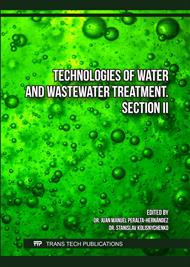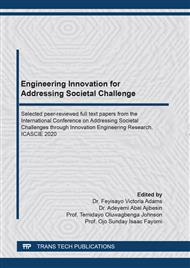[1]
Kalbamatten, J.M., and Burns, M.J. (1983). Water Supply and Sanitation in Developing Countries. B.J Dangerfield, IWES. London, England.35-40p.
Google Scholar
[2]
WHO/UNICEF, (2000). Inequality in Access to Clean Water and Sanitation. Vital Water Graphics. An Overview of the State of the World's Fresh and Marine Waters. 2nd Edition-2008. Retrieved from http://www.unep.org/dewa/vital/water/article63.html.11p.
Google Scholar
[3]
Ali, E.N., Muyibi, S.A., Salleh, H.M., Alam, M.D.Z., and Salleh, M.R.M. (2010). Production of Natural Coagulant from Moringa oleifera for Application in Treatment of Low Turbid Water.Journal of Water Resources and Protection. 19(2):259-266.
DOI: 10.4236/jwarp.2010.23030
Google Scholar
[4]
Koleten, K.,Kocak, A.,Kaplan, M. (2011). Tannin Protein and fatty Acids composition of the seeds of some Trifolium L. Species from Turkey.http://scialet.net/fullest/? 2011.88.95.
Google Scholar
[5]
Moramudaii, M.A., and Fernando, P. (2001). Use of Seeds of Moringa oleifera to Clarify TurbidWaters and Wastewaters, Vidyodaya Journal of Science.Vol. 10, pp.167-182.
Google Scholar
[6]
Adejumo, M., Oloruntoba, E.O., and Sridhar, M.K. (2013).Use of Moringa oleifera (Lam) Seed Powder as a Natural Coagulant for Purification of Water from Unprotected Sources in Nigeria. European Scientific Journal. 2013.9(24):214-229.
Google Scholar
[7]
Ghebremichael, K.A. (2004). Moringa Seed and Pumice as Alternative Natural Materials for Drinking Water Treatment.204-210p Available from hhtp\\:www.ircwash.org,sites,default,files.
Google Scholar
[8]
Ida, B. (2013). Coagulant protein from plant materials: potential water treatment agent. Royal Institute of Technology Stockholm.10-15p.
Google Scholar
[9]
Ndabigengesere, A., Narasiah, K.S., Talbot, B.G. (1995). Active Agents and Mechanism of Coagulantion of Turbid Water Using Moringa oleifera Seed. 29(.2):703 -710. Water Research.
DOI: 10.1016/0043-1354(94)00161-y
Google Scholar
[10]
Yongabi, K.A., Lewis, D.M., Harris, P.L. (2011). Indigenous Plant Based Coagulants/Disinfectants and Sand Filter Media for Surface Water Treatment in Bamenda, Cameroon A frican JournalofBiotechnology 10(43):8625-8629.
DOI: 10.5897/ajb10.1709
Google Scholar
[11]
Oluduro, O.A., Aderiye, B., Connolly, J.D., Auntayo, E.T. and Famurewa, O. (2010). Characterization and Antimicrobial Activity of (4-βd-glucopyranosyl – 4-a-1 Rhamnopyranosyloxy)-Benzyl thiocarbonaxamioc acid.Novel on Bioactive Compounds from Moringa oleifera Extract. Folia microbiology, 55(5):422-426.
DOI: 10.1007/s12223-010-0071-0
Google Scholar
[12]
Chang S.K.C (2003). Protein Analysis. Food Analysis, Nielsen S.S.(Ed.).135-156(3)10-35.Kluwer Academic Plenum Publisher,New York.10p.
Google Scholar
[13]
AOAC, (1990a). Official Method of Analysis of the Association of Chemist.Washington, DC.,pp: 223-225, 992-995.
Google Scholar
[14]
AOAC, (1990b). Official Method of Analysis of the Association of Chemist.Washington, DC.,pp: 226- 254, 996-1000.
Google Scholar
[15]
AOAC, (1990c). Official Method of Analysis of the Association of Chemist.Washington, DC.,pp: 223-225, 992-995.
Google Scholar
[16]
APHA, (1998a). Method for the Examination of Water and Wastewater. 20thEdition, Washington DC,1 998.
Google Scholar
[17]
APHA, (1998b). Method for the Examination of Water and Wastewater. 20thEdition, Washington DC,1 999-1000.
Google Scholar
[18]
Koleten, K.,Kocak, A.,Kaplan, M. (2011). Tannin Protein and fatty Acids composition of the seeds of some Trifolium L. Species from Turkey.http://scialet.net/fullest/?.2011.88.95.
Google Scholar
[19]
E.P.A. (2001). Parameters of water quality; Interpretation and standards.pp.44-95 An Ghniomhaireacht um Ghaomhnu Comhsaoil. Johnstown Castle, co,Wexford. Ireland.
Google Scholar
[20]
E.P.A. (2001). Parameters of water quality; Interpretation and standards.pp.44-95 An Ghniomhaireacht um Ghaomhnu Comhsaoil. Johnstown Castle, co,Wexford. Ireland.
Google Scholar
[21]
Muyibi, S.A. Noor, M.J., Ding, T.O., and Khon, W.K.(2001).Moringa oleifera Seeds as a Flocculant in Waste Sludge Treatment.International Journal of Environmental Studies. 58,185-195. dol.org/10.1080/00207230108711326.
DOI: 10.1080/00207230108711326
Google Scholar
[22]
Robert, L., Mathe, S.,Michael, R.,Sabtri, K., and Kiran, B. (2009). Disinfection of Waterborne Coliform Bacteria by Neem Oil. Environmental Engineering Sciences.26:1435-1441.
DOI: 10.1089/ees.2009.0058
Google Scholar
[23]
World Health Organization, (WHO, 2006). Guidelines for Drinking Water Quality, 1st Addendum to the Recommendations, World Health Organization, Geneva, Switzerland. 2006;3 (1) 16-25.
Google Scholar
[24]
Gidde M.R., Bhalera A.R., and Majithia H.M.(2008).Moringa oleifera – Household Alternative Coagulant for Water Treatment. Paper for National Conference on Household Water Treatment Technology' at College of Science.and Technology. Farah, Mathura. On 24 and 25th July2008.
Google Scholar
[25]
Manju,N., Vaishnava, C.S. (2018). Proximat Analysis of Moringa Oleifera. International Journal of Chemical Studies. IJCS 2018; 6(4): 563-566.
Google Scholar
[26]
Doerr, B. (2005). Field Guidelines for Emergency Water Treatment with Moringa oleifera.pp.2-5. Availableonlinefrom www.Cawst.org/technology/watertreatment/filtrationbiosandanphp.Accessed 20th Nov.(2014).
Google Scholar
[27]
Muhammad, I.M., Abdulsalam, A., and Bello, A.A. (2015a). Watermelon seed as a potential coagulant for water treatment. Global journal of researches in engineering.Chemical engineering 15(1), 6-8 .Global Journals Inc. U.S.A.
Google Scholar
[28]
Muhammad, I.M., Abdulsalam, A., and Bello, A.A. (2015b). Watermelon seed as a potential coagulant for water treatment. Global journal of researches in engineering.Chemical engineering 15(1), 10-11 .Global Journals Inc. U.S.A.
Google Scholar
[29]
Arnoldsson, E., Bergman, M., Matsinhe, N. and Persson, K. (2008). Assessment of drinking water treatment using Moringa oleifera natural coagulant p.137–150.',VATTEN.
Google Scholar
[30]
Yongabi , K. A. , Lewi s, D. M. , Harris, P. L. ( 2011) .Indigenous Pl ant Based Coagulants/Disi nfectants and Sand Filter Media for Surface Water Treatment in Bamenda, Cameroon African Journal of Biotechnology10( 43) : 86258629.
DOI: 10.5897/ajb10.1709
Google Scholar



